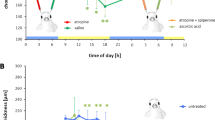Abstract
Eyes of young chickens show diurnal oscillations in axial length and choroidal thickness that are out of phase. In eyes responding to myopic defocus induced by prior form deprivation, the two rhythms shift into phase. In order to elucidate the possible role for these rhythms in ocular growth regulation, they were measured under visual conditions that altered ocular growth rate. (1) Form deprivation to myopic defocus. Eyes of chicks were monocularly deprived for 5 days. Diffusers were removed. (2) Myopic defocus to hyperopic defocus. Eyes wore positive lenses for 6 days; lenses were removed. (3) Hyperopic to myopic defocus. Eyes wore negative lenses for 5 days; lenses were removed. Eyes were measured using A-scan ultrasonography at 6-h intervals for 24 h over various cycles. The rhythms shift into phase in eyes slowing their growth in response to myopic defocus in all three conditions. This shift precedes by 1 day the decrease in growth in both lens conditions, and is concomitant with it in recovering eyes. There is a positive correlation between the phase difference and growth rate. In conclusion, there is a consistent association between growth rate and phase relationships of the rhythms in axial elongation and choroidal thickness.









Similar content being viewed by others
Notes
The technique of subtracting the linear regression from the data has been shown to be an effective one in that for normal growing eyes, the residuals are very well fit to a sine wave (see Nickla et al. 1998). However, in some of these data the mean start and end values resulting from this analysis differ somewhat (Figs. 2, 5, 7). The phase differences that would result from adding a slope that would result in these differences onto a sine wave are 1.1, 1.5 and 1.3 h, respectively. These small errors are unlikely to bias the statistics.
References
Kee CS, Marzani D, Wallman J (2001) Differences in time course and visual requirements of ocular responses to lenses and diffusers. Invest Ophthalmol Vis Sci 42:575–583
Marzani D, Wallman J (1997) Growth of the two layers of the chick sclera is modulated reciprocally by visual conditions. Invest Ophthalmol Vis Sci 38:1726–1739
Mertz JR, Wallman J (2000) Choroidal retinoic acid synthesis: a possible mediator between refractive error and compensatory eye growth. Exp Eye Res 70:519–527
Nickla D, Johnson C, Lytle G (2004) Phase relationships between the diurnal rhythms in axial length and choroidal thickness and their association with ocular growth rates in chicks. Invest Ophthalmol Vis Sci [E-Abstract] 45:1158
Nickla D, Sharda V, Troilo D (2005) Temporal integration characteristics of the axial and choroidal responses to myopic defocus induced by prior form deprivation versus positive spectacle lens wear in chickens. Optom Vis Sci 82:318–327
Nickla D, Troilo D (2001) Brief daily periods of vision cause rapid, transient changes in axial length and choroid thickness in form deprived chick eyes. Invest Ophthalmol Vis Sci 42(Suppl):1604
Nickla D, Wildsoet C, Troilo D (2001) Endogenous rhythms in axial length and choroidal thickness in chicks: implications for ocular growth regulation. Invest Ophthalmol Vis Sci 42:584–588
Nickla D, Wildsoet C, Troilo D (2002) Diurnal rhythms in intraocular pressure, axial length, and choroidal thickness in a primate model of eye growth, the common marmoset. Invest Ophthalmol Vis Sci 43:2519–2528
Nickla DL, Wildsoet CF, Wallman J (1996) Myopic defocus, but not form-deprivation, causes large phase shifts in diurnal rhythms of choroid thickness and of axial length. Invest Ophthalmol Vis Sci 37(Suppl):687
Nickla DL, Wildsoet C, Wallman J (1997) Compensation for spectacle lenses involves changes in proteoglycan synthesis in both the sclera and choroid. Curr Eye Res 16:320–326
Nickla DL, Wildsoet C, Wallman J (1998) Visual influences on diurnal rhythms in ocular length and choroidal thickness in chick eyes. Exp Eye Res 66:163–181
Papastergiou GI, Schmid GF, Riva CE, Mendel MJ, Stone RA, Laties AM (1998) Ocular axial length and choroidal thickness in newly hatched chicks and one-year-old chickens fluctuate in a diurnal pattern that is influenced by visual experience and intraocular pressure changes. Exp Eye Res 66:195–205
Rada JA, McFarland AL, Cornuet PK, Hassell JR (1992) Proteoglycan synthesis by scleral chondrocytes is modulated by a vision dependent mechanism. Curr Eye Res 11:767–782
Rada JA, Thoft RA, Hassell JR (1990) Extracellular matrix changes in the sclera of chickens with experimental myopia. Invest Ophthalmol Vis Sci [Suppl] 31:253
Smith EL, Hung LF, Harwerth RS (2000) The degree of image degradation and the depth of amblyopia. Invest Ophthalmol Vis Sci 41:3775–3781
Stone RD, Quinn GE, Francis EL, Ying G, Flitcroft DI, Parekh P, Brown J, Orlow J, Schmid G (2004) Diurnal axial length fluctuations in human eyes. Invest Ophthalmol Vis Sci 45:63–70
Wallman J, Wildsoet C, Xu A, Gottlieb M, Nickla D, Marran L, Krebs W, Christensen A (1995) Moving the retina: choroidal modulation of refractive state. Vis Res 35:37–50
Wildsoet C, Wallman J (1995) Choroidal and scleral mechanisms of compensation for spectacle lenses in chicks. Vis Res 35:1175–1194
Acknowledgements
The author thanks Grace Lytle and Catherine Johnson for assistance with some of the ultrasound measurements. Thanks also to Heidi Denman and Kristen Totonelly for care of the chickens. This work was supported by NIH-EY-13636. All experiments conformed to the ARVO Resolution on the Use of Animals in Research.
Author information
Authors and Affiliations
Corresponding author
Rights and permissions
About this article
Cite this article
Nickla, D.L. The phase relationships between the diurnal rhythms in axial length and choroidal thickness and the association with ocular growth rate in chicks. J Comp Physiol A 192, 399–407 (2006). https://doi.org/10.1007/s00359-005-0077-2
Received:
Revised:
Accepted:
Published:
Issue Date:
DOI: https://doi.org/10.1007/s00359-005-0077-2




